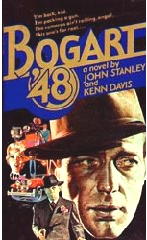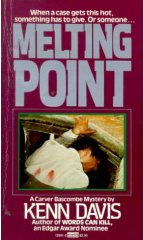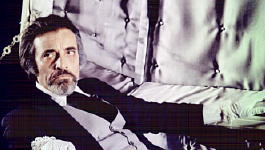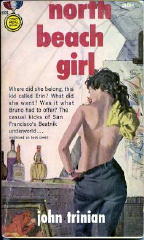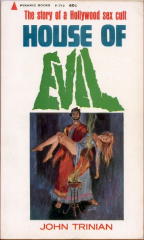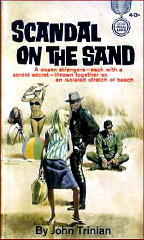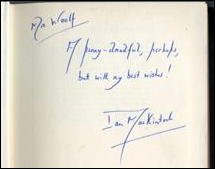May 2008
Monthly Archive
Fri 23 May 2008
Posted by Steve under
Authors ,
ReviewsNo Comments
AILEEN SCHUMACHER – Affirmative Reaction.
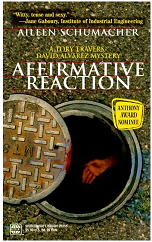
Worldwide, paperback reprint, July 2000. Hardcover edition: Write Way, 1999.
Over the course of years, many things change, and the ingredients that make up mystery stories are no exception. It’s quite a jump from 1946 to 1999, and there’s an quantum jump of difference between this book and the one just preceding.
[Note: Referred to in the paragraph above is my review of The Case of the Fan-Dancer’s Horse, by Erle Stanley Gardner, posted here on the M*F blog several weeks back. Fan-Dancer was published in 1946.]
Let’s get to the story first. Tory Travers is a working engineer. (I’d better add that she’s female.) Trying to uncover the problem the storm drains are having in an abandoned housing development, she discovers a body. The woman worked for the city, as it happens, and she was a notorious opponent of affirmative action. Her past record also includes some political dealings with the project, and immediately popping into everyone’s mind is the fact that the contractor (Hispanic) committed suicide soon after his contract was canceled.
Detective David Alvarez has run into Tory before. This is not the first body she has found — apparently she has been making a habit of it. This is their third case together. And they are romantically involved, or at least that’s what David Alvarez is hoping. Tory is resisting.
So. While the sparks between the two fly, they’re also solving the mystery — and the twists and turns their love life takes them is more of a tangle than the trail they follow in uncovering the culprit. There are very few suspects, and the finger soon points to one of them only.
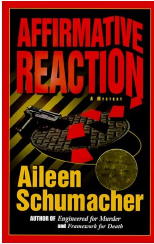
In the Perry Mason stories, the focus is on whodunit, and nothing else. Where Perry Mason lives, no one knows. Who he’s dating — besides the occasional steak dinner with Della — no one has a clue. If his contrary father comes to visit, as Tory’s does, we never hear of it. Perry with teen-agers underfoot, such as Tory has? Not a chance in the world.
Things change. And Schumacher’s book is fun to read. More, she sets it up beautifully for the reader to quiver in anticipation while waiting for what’s next in store for these sometimes-yes-sometimes-no lovers — and that’s no small success.
You’ll notice that I didn’t say much about the detective work, though.
— August 2000
The Tory Travers mysteries. The link leads to Aileen Schumacher’s website, where the information below was obtained:
Engineered for Murder. Write Way, hc, August 1996; trade ppbk, January 1997.
Framework for Death. Write Way, hc, 1998; Worldwide, pb, May 2000. 1999 Anthony Award nominee.
Affirmative Reaction. Write Way, hc, 1999; Worldwide, pb, July 2000.
Rosewood’s Ashes. Intrigue Press, hc, May 2001; Worldwide, pb, May 2001.
Fri 23 May 2008
REVIEWS BY WALTER ALBERT:
VICTORIA LAURIE – What’s A Ghoul To Do? “A Ghost Hunter Mystery.”
Signet, paperback original, April 2007.
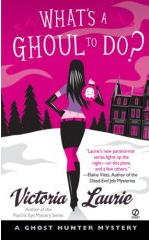
Victoria Laurie is described in the inner back-cover copy as a “real-life psychic,” author of the Psychic Eye series that features Abby Cooper. She’s apparently branching out with a new series in which medium M. J. Holliday and her sidekick Gilley Gillespie help souls stuck on this “side” cross over.
This is psychic lite as M. J. and Gilley (who functions as her manager, and has a notable aversion to spooky manifestations) attempt to help the grandfather of Dr. Steven Sable cross over, a job that’s more difficult than they expect and involves some real-life characters with larceny on their mind and no objection to murder.
And, to complicate matters, M. J. has to break one of her prime rules, which is that nobody accompanies her on her ghost-busting for a very attractive doctor, grandson of the dead – and possibly murdered – ghost.
The psychic lite elements pretty much drain the novel of any suspense, but the characters are appealing, and there’s enough ghostly business to keep a ghost fancier like me reasonably entertained.
VICTORIA LAURIE – A Vision of Murder “A Psychic Eye Mystery.”
Signet, paperback original, December 2005.
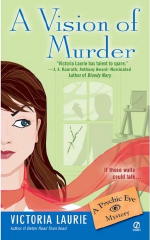
I was looking for another M. J. Holliday Ghost Hunter mystery, but all I found on the shelf at the Mystery Lovers Bookshop was the third in an earlier series whose protagonist is Abby Cooper. Abby’s a professional psychic who’s taking some time off from her psychic readings to enter into a real-estate venture with her sister (“Cat”) and handyman (“Dave”) that involves fixing-up a very run down house.
(I liked this hook since my wife and I entered into a similar agreement some years ago with a handyman to a house in our neighborhood that was up for a sheriff’s sale.)
Unfortunately, the house seems to have two very active spooks, and a mysterious intruder whose intentions are just as threatening as those of the resident haunts, and a good deal more deadly.
These two books constitute a pleasant addition to my meager supply of contemporary conventional supernatural fiction (somewhat overloaded, I’ve concluded, with vampire novels). I like the author’s carefree but committed approach to the dark side and hope to visit her spectral world again.
Psychic Eye Mysteries:
1. Abby Cooper, Psychic Eye (Signet, December 2004)
2. Better Read Than Dead (Signet, June 2005)
3. A Vision of Murder (Signet, December 2005)
4. Killer Insight (Signet, September 2006)
5. Crime Seen (Obsidian, September 2007). [Reviewed earlier by Steve here.]
6. Death Perception (Obsidian, September 2008)
Ghost Hunter Mysteries:
1. What’s a Ghoul to Do? (Signet, April 2007)
2. Demons Are a Ghoul’s Best Friend (Signet, March 2008)
Thu 22 May 2008
IT’S ABOUT CRIME
by Marvin Lachman
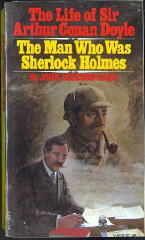
One of the beneficiaries of the [recent] Sherlock Holmes “boom” was John Dickson Carr’s excellent 1949 biography of Sir Arthur Conan Doyle which was reprinted by Vintage in paperback in 1975. “Renaissance man” is a term too frequently used nowadays and applied to anyone who can both read and write. There are some people to whom it applies. Anthony Boucher was one. Doyle was certainly another with his knowledge and ability in such diverse fields as medicine, literature, politics, sports, medieval history, and military tactics. Furthermore, as Carr clearly shows, Doyle was a “‘doer,” a man who accomplished an incredible amount in his lifetime.
Carr gives most of his attention to the non-Holmesian Doyle, and there is much to be learned on many non-mystery subjects – e.g., South Africa. Without saying so, Carr clearly shows how today’s apartheid problems had their roots in the Boer rebellion at the turn of the 20th Century. Doyle went to South Africa, in charge of a field hospital, and published a history of the war on his return.
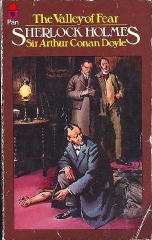
Though he is generally objective, Carr occasionally intrudes, getting in a few digs at Socialist Britain which he left at about the time he was writing this book. He also, I am glad to say, doesn’t entirely forget that he was one of the best Holmesian scholars around. He especially enjoyed The Valley of Fear which, unlike most critics, he considered Doyle’s best mystery novel.
The Valley of Fear is based on the 19th Century violence in the Pennsylvania coal fields. Doyle became familiar with this through his friendship with William Pinkerton, son of the famous detective. An engrossing non-fiction account of this strife is Wayne G. Broehl’s The Molly Maguires (1964), originally written as a dissertation at Harvard and reprinted in paperback, as part of a series on American violence, by Chelsea House/Vintage.
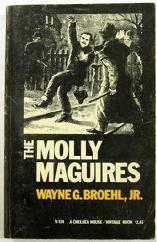
This is a book which, in addition to being a fine history, offers many bonuses to the reader. For example, there is the origin and correct usage of the much mis-used expression “reading the riot act.” Also, for students of perhaps the smallest sub-genre within the mystery (“exchanged murders” as used by Patricia Highsmith, Nicholas Blake, and Evelyn Berckman), there is a historical example of this. In Ireland, rebels, in various counties, would mutually import strangers to commit murders against landholders, thus permitting alibis and suspects who had no apparent motive.
Though it was the “Golden Age” of detection, thrillers were also popular about the time that Doyle stopped writing of Holmes. Furthermore, lest you believe that the drug problems of the 1960’s and 1970’s are either new or unique, you should consult English thrillers of this time. A.S.F. The Story of a Great Conspiracy (1924) by John Rhode is a good example, a fast-moving book about the drug traffic in England and Europe and how it affects members of the British upper classes.
This is a book with enough coincidences to choke a horse, or at least a reader. I wouldn’t dream of detailing them because part of the fun in this book is reading them and saying “WHAT!” as they occur. One of Rhode’s characters sums up the situation nicely when he refers to “just one of those malicious strokes of Fate which endows men’s actions with a grim humour.”
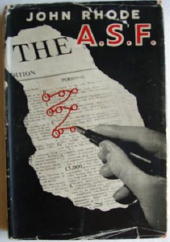
However, in case you never get closer to this book than my review, I suppose I should quote Rhode’s last paragraph:
“What does all that distant past matter?” he said eagerly. “Let us begin again from now, let us forget the clouds that have hung over us, and go out together, you and I, to meet the morning. Let all the long wasted years pass with the night to leave us nothing but the sunshine of happiness.”
And, yet, with all that is corny, there is a vitality of writing here that is very apparent in this, Rhode’s first book. It would lead to a grand, prolific career with well over one hundred mysteries for this author who gave pleasure to many but whom Julian Symons derided and whom hardly anyone reads today.
Just as much fun is Gerard Fairlie’s The Muster of the Vultures (1929), a thriller in which Robin Murdoch does battle against “the best brains of the criminal profession … joined together under one genius of organizations.” I frankly loved such other examples of comic book dialogue in this book as:
1. “I am much too powerful for the police of any country to suppress.”
2. “We meet again, Robin Murdoch!”
3. “Curse him, I say, for the foul fiend that he is!”
4. “Take that, you hound!” he cried. “Take that! and that! and that!”
Books reviewed or discussed in this installment:
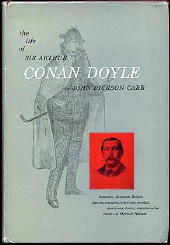
JOHN DICKSON CARR – The Life of Sir Arthur Conan Doyle: The Man Who Was Sherlock Holmes. Harper & Row, hardcover, 1949. Vintage Books, paperback, 1975. Carroll & Graf, trade paperback, 1987. Da Capo Press, trade paperback, November 2003
ARTHUR CONAN DOYLE – The Valley of Fear. Smith-Elder, UK, hc, 1915. George H. Doran, 1915. Reprinted many times and the basis for several films.
WAYNE G. BROEHL, JR. – The Molly Maguires. Harvard University Press, hardcover, 1964. Vintage/Chelsea House Book, softover, 1968.
JOHN RHODE – A.S.F.: The Story of a Great Conspiracy. Geoffrey Bles, UK, hardcover, 1924. US title: The White Menace. McBride, hc, 1926.
GERARD FAIRLIE – The Muster of the Vultures. Hodder & Stoughton, UK, hardcover, 1929. Little-Brown & Co, US, hc, 1929.
Reprinted from the
The MYSTERY FANcier, Mar-Apr 1979.
Thu 22 May 2008
At the end of my previous post on Zekial Marko, better known to paperback collectors and mystery fans as John Trinian, I hinted at a small piece of information that turned up in his online obituary.
Namely, that Marko had a brother named Kenn Davis. The double N immediately caught my eye. Could this be the same Kenn Davis, the mystery writer? Turns out that he is, and I hadn’t known it before. It was also news to Al Hubin, author of Crime Fiction IV, but after doing some investigating on my own, if it was a secret, it hasn’t been very well kept. People on various blogs and Yahoo groups have pointed it out on several occasions in the past.
So it’s not exactly breaking news, but it’s still reason enough to talk about Kenn Davis’s books. Expanded slightly from his entry in CFIV:
DAVIS, KENN. 1932- . Series character: CB = PI Carver Bascombe. All books are paperback originals.
The Dark Side [with John Stanley]. Avon 30957, pb, December 1976. [CB]
The Forza Trap. Avon 44552, pb, June 1979 [CB]
Bogart ’48 [with John Stanley]. Dell 10853, pb, February 1980
Dead to Rights. Avon 78295, pb, August 1981
Words Can Kill. Gold Medal 12667, pb, May 1984 [CB]
Melting Point. Gold Medal 12901, pb, May 1986. [CB]
Nijinsky Is Dead. Gold Medal 13096, pb, 1987 [CB]
As October Dies. Gold Medal 13097, pb, 1987 [CB]
Acts of Homicide. Gold Medal 13351, pb, 1989 [CB]
Blood of Poets. Gold Medal 13352, pb, 1990 [CB]
In spite of the number of books, I have a feeling that both Kenn Davis and Carver Bascombe are fairly well forgotten today. Even though I believe I have all but one or two of the books, they’re boxed away where I can’t get at them. (You’ve heard that before.) So far I’ve been able to come up with only a few cover images, which you will see both above and below.
But did you know, as I certainly didn’t — and I’ll get back to Carver Bascombe shortly — that Kenn Davis is also a well-known California-based artist, and has been for over 50 years? Taken from a website illustrating some of his work, one of which is shown here:
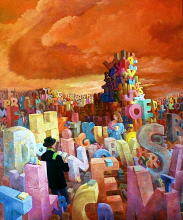
“KENN DAVIS has devoted his 53 year painting career to the interpretation of life in his own time. Associated with the North Beach Scene in the 1950s, he has continued to work with his chosen SURREALISTIC concepts, frequently in a satirical vein. In exhibitions throughout his home state of California, as well as in New York, Chicago, Boston, Houston and in Museums shows in San Francisco and Dallas, Davis has demonstrated his fascination with imagination. His work is often disconcerting and deliberately so. ‘There is enough art that lulls us into feeling right with the world, but to be stimulated by the artist brings us to another level of appreciation.’”
Kenn Davis and John Stanley also co-wrote the screenplay for the comedy-horror film Nightmare in Blood, the storyline described on IMDB as: “Attendees at a horror-film convention in San Francisco keep disappearing. It turns out that the guest of honor is a real vampire…” Kenn Davis was the producer, and John Stanley directed. More on the making of the movie here, written by John Stanley himself. (No, that is not him in the coffin below.)
As for Carver Bascombe, from the second of the two websites linked to in the above paragraph, Stanley says:
“One other thing we shared in common was an interest in science-fiction and horror. We also liked mysteries and in early 1970 had begun working on a private-eye screenplay,
The Dark Side of the Hunt.
“It was Kenn’s idea to write a story about a black San Francisco detective named Carver Bascombe. (This was before anyone had ever heard of John Shaft or Richard Roundtree.) We had even found a San Francisco-based stage actor, John Cochran, to play the Bascombe role.
“And then came a big mistake: American-International offered to buy the script from us, but because we had promised John Cochran that the three of us would make the film come hell or high water, we turned it down. (Primarily because they wanted the script without us attached as would-be film wreckers.) We should have taken the offer but we were young and idealistic–and very idiotic.
“(Dark Side of the Hunt didn’t completely die. A few years later it would be novelized by Kenn as The Dark Side –- my name was on it but I really didn’t write it –- and published by Avon. Kenn would go on to write an entire series about Carver and his San Francisco adventures.)
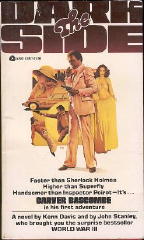
As it happened, The Dark Side was nominated for an Edgar in 1976 as Best Paperback Original. (Note that by the time the book was published, the movie Shaft had already appeared, in 1971, based on Ernest Tidyman’s 1970 novel) From the cover of The Dark Side:
“Faster than Sherlock Holmes, Higher than Superfly, Handsomer than Inspector Poirot — It’s CARVER BASCOMBE, in his first adventure.”
Kevin Burton Smith in the online January Magazine has this to say about the series:
“For those who want a P.I. with good taste, you can hardly do better than Carver Bascombe, originally created by Kenn Davis and John Stanley in
The Dark Side (1975), but continued for the next seven books by Davis alone, the series concluding with 1990’s
Blood of Poets.
“Bascombe’s a young Vietnam vet with a military police background, who’s now an ambitious, art-loving private eye and part-time student working his way through law school in San Francisco. Bascombe’s passion comes in handy, because his cases invariably involve the arts somehow, be it opera, drama, literature, art photography, ballet, painting or poetry.
“The first few novels in this series were uneven, but by the fourth one, the Shamus-nominated Melting Point (1986), Davis had really hit his stride, with Bascombe sweating out a long, hot summer waiting to hear if he’s passed the bar, while at the same time he hunts down a missing sculptor.”
Of special note, the link above leads to a long article by Kevin about black PI’s, a complete overview from a historical perspective. It’s well worth your reading.
[UPDATE] 01-18-10. I have bad news to report. Kenn Davis died six days ago at the age of 77. For a wonderful tribute to him as an author, check out Jeff’s piece about him on The Rap Sheet. I am pleased to say that Mr. Davis saw this post I did on him (see Comment #7). I am not pleased to say that in spite of all good intentions, an interview I kept meaning to do with him never happened. I wish it had.
Wed 21 May 2008
It was Juri Nummelin who on his blog was one of the first to post the news of Zekial Marko’s passing. A brief obituary can be found in its entirety on the Writers Guild of America website.
Here’s a shortened version:
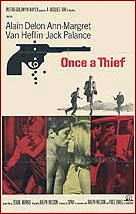
“Veteran writer and long-time Writers Guild of America, West (WGAW) member Zekial Marko died on Friday, May 9, of complications related to emphysema in Centralia, Washington.
“Born in 1933 and a WGAW member since 1964, Marko maintained a lengthy career writing for both small and silver screens. His television credits include episodes of The Rockford Files, Kolchak: The Night Stalker, and Toma, while his screen credits include the 1964 film Once a Thief, based on his novel.
“Marko is survived by his wife, Sue, his two daughters, Belle and Zefra, his son, Zoyan, and his brother, Kenn Davis.”
Marko’s list of TV credits would in itself qualify his death be mentioned on this blog. What the obituary does not say, however, but what has been known to fans of his work for some time, is that he was also “John Trinian,” author of a small eclectic set of mystery and crime paperbacks written back in the 1960s.
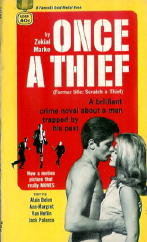
It turns out that Al Hubin already knew this – the name behind the names is included in Crime Fiction IV, as you can easily check. What’s not there, but will appear in the next installment of the online Addenda — and right here, right now, of course — is any biographical information about Markos, including the year he was born (1933) and the fact that his name at birth was Marvin Leroy Schmoker. The latter Juri learned from a relative of Marko’s who contacted him after he died, perhaps because Juri had written about John Trinian on his blog and elsewhere.
Based on and expanded from his entry in CFIV, here’s the list of all of Trinian’s paperback mystery fiction:
A Game of Flesh. Bedside Book BB106, 1959; Lancer/Domino 72-678, 1963; Macfadden 75-360, 1970. “An explosive novel of a wanton gigolo and the love-starved women he shamed!”
The Big Grab. Pyramid G548, 1960; Manor 95230, 1973. Reprinted earlier as Any Number Can Win. Pyramid F-925, 1963. “Their take would be a cool quarter of a million-or a hot slug in the gut.” Film: Cipra, 1963, as Melodie en Sous-Sol (Basement Melody). Released in Britain as The Big Grab; released in the U.S. as Any Number Can Win. Stars: Jean Gabin, Alain Delon.
North Beach Girl. Gold Medal s1000, 1960. Reprinted as Strange Lovers. Macfadden 60-301, 1967. [A novel set in the San Francisco beat world of the Fifties.]
The Savage Breast. Gold Medal s1104, 1961; Macfadden 60-330, 1968. “Born beautiful, spoiled rotten..was she a goddess to be loved or a tigress to be tamed?”
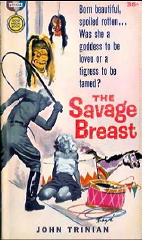
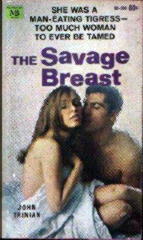
Scratch a Thief. Ace Double F-107, 1961. Also published as: Once a Thief. Gold Medal k1569, 1965, as by Zekial Marko; and under the latter title as by John Trinian: Manor 95272, 1973. “A blood and guts book about a cop with a grudge and an ex-con who wanted to go straight…” Film: MGM, 1965, as Once a Thief; in French: Les Tueuers de San Francisco. (scw: Zekial Marko; dir: Ralph Nelson). Stars: Alain Delon, Ann-Margret. [Go here for a short clip from the film.]
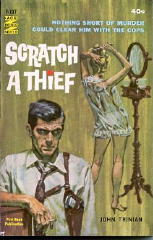
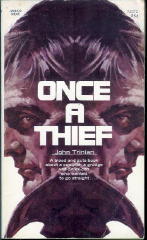
House of Evil. Pyramid F-712, 1962. [?? Macfadden-Bartell, 1970] “The story of a Hollywood sex cult.”
Scandal on the Sand. Gold Medal k1449, 1964. Macfadden-Bartell 75-338, 1970.
Reviews or commentary on Trinian’s work are few and hard to come by, but on Ed Gorman’s blog he had this to say, not too long ago:
“A few weeks ago I reviewed a 1964 Gold Medal novel called
Scandal on The Sand by John Trinian. Really fine pb. The structure was masterful and the social observation surprisingly rich. And the plot cooked. This guy knew how to tell a story. And the writing was equal to the other aspects of the tale. Deft turns of phrase; conscious rhythms in the sentences; interesting, even entertaining word choices.”
What better things could one writer say about another? A fitting way to end this short tribute, I hope you’ll agree.
[UPDATE.] Later the same day. Keen eyes on your part may have noticed the same thing I did. It is true, it is he, and this small bit of information is what a followup post, coming up soon, will be all about.
Tue 20 May 2008
REGINALD DAVIS – The Crowing Hen.
Doubleday Crime Club, hardcover, 1936. UK edition: Gordon Bles, hc, 1936.

The first thing you notice about Davis’s writing is his nicely wry sense of humor, you know, the kind that sort of sneaks up on you. Consider, for example, the superstitious reaction of the villagers of Hayes Coombe to the crowing of hens – wholesale slaughter in the feathered world! – and what one of a pair of real estate agents fears that this will do for the price of poultry….
Precipitating this crisis is the impending sale of the mansion Danes Priory, said by some to be haunted, to a young couple about to be married. Warnings like footprints of blood and a dead Buff Orpington – or was it a Speckled Wyandotte? – are ignored, and mysterious death strikes, not once, but twice.
Complicating matters is a fortune in unfenced stolen diamonds, but what Davis is more concerned with is his mystery-horror show that in no way is as intellectually gripping as a solid detective puzzle would have been. With facts as fragile as these, and a story that seems always to be heading off in the wrong direction, atmosphere just isn’t enough.
The early promise of a reading treat in store is not kept. This was Davis’s first mystery novel. He wrote only one other. [D]
– From The MYSTERY FANcier, Vol. 3, No. 2, Mar-Apr 1979.
[UPDATE] 05-20-08. I knew this day was coming, and to tell you the truth, I’ve been putting it off for quite a while now. I wrote this review nearly 30 years ago, and I have the strongest feeling that if I were to read this book again, I’d have a strong quarrel with myself on the merits of this book.
To me now, and from what little I remember of this book, it sounds exactly like something I’d love to read, little emphasis on the detective end of things or not. If only I could locate my copy, I’d let you know for sure.
But since I haven’t – located my copy, that is – I’ve decided to let my younger self have his say, with only this one small hint to suggest that I may have been wrong.
There’s one thing that I was definitely wrong on, and that’s how many mysteries Reginald Davis wrote. It must be that reference books back in 1979 hadn’t caught up with one of them, since in Crime Fiction IV now, here’s what Al Hubin lists for him:
DAVIS, REGINALD
* The Crowing Hen. Bles, UK, hc, 1936. Doubleday Crime Club, US, hc, 1936.
* Nine Days’ Panic. Bles, UK, hc, 1937. Doubleday Crime Club, US, hc, 1938.
* Twelve Midnight Street. Bles, UK, hc, 1938.
The latter is a scarce book. I found no copies offered for sale on the Internet when I searched just now.
There’s no biographical information about Davis I can tell you about, neither from CFIV nor the Crime Club jackets, so says Bill Pronzini about the latter. It was he who provided both of the covers you see here in this post.
Here’s Bill’s opinion on The Crowing Hen, cobbled together from a couple of emails as we were discussing the book. (This is just his end of the conversation, you understand.)
“I read
Hen a few years ago and liked it a lot; all sorts of wild, wonderful, and horrific happenings rather neatly wrapped up, I thought. […]
“I wasn’t sure I liked The Crowing Hen at first, either. Farfetched to the point of absurdity in places. But the macabre atmospherics kept me reading, and I thought Davis did an admirable job of explaining the various weird happenings.”
So there you have it. Two opinions, one of which the author is only partially standing behind. If you’ve read the book, why not add yours? I’d love to hear from you.
Mon 19 May 2008
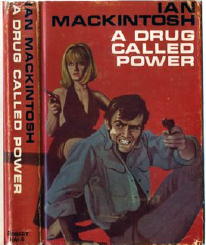
A week or so ago thriller writer Ian Mackintosh was mentioned in one of the Addenda updates to Al Hubin’s Crime Fiction IV. A correction was made to the spelling of his name, from MacKintosh to Mackintosh. A minor matter, perhaps, but some of us care. There is, after all, a difference between John D. MacDonald and Ross Macdonald, and how they spelled their respective names.
The matter was settled, I thought, since on all of the covers of Mr. Mackintosh’s books that I’ve been able to locate so far, that is the way his name’s been spelled. But UK mystery bookseller Jamie Sturgeon has sharp eyes. He has an inscribed copy of one of the author’s books — see above — and while I am right and his name is spelled Mackintosh on the cover, lo and behold, he spelled his name MacKintosh in the inscription.
Take a look and see if you don’t agree:
[UPDATE.] Later the same afternoon. Al Hubin points out that: “On the other hand, as I recall, Ian’s brother has a web page for him and there it’s Mackintosh … I think I’ll stick with the name as presented on his books.”
The web page that Al refers to [follow the link above] is worth your time looking into. Ian’s brother Lawrie talks about not only Ian’s early life and his work for the BBC, but also Ian’s mysterious disappearance over the Kodiak Islands in July 1979.
Mon 19 May 2008
Posted by Steve under
Inquiries[2] Comments
The past few weeks have busy if not increasingly hectic for me, and I have in hand an ever-growing amount of email that I’ve not replied to or to followed up on as I’ve agreed to. To remedy the situation, I think I’ll take this week on the blog to get catch up on as many of these as I can.
Some of these have been inquiries, and if I’ve been able to answer, I have. Some I haven’t been able to answer, such as this from John Herrington, over in the UK:
Hi Steve,
Once again a plea for help.
I desperately need to find out if the New York Herald Tribune carried an obituary for one of its journalists who died in November 1935. Do you know anyone in New York who uses the library’s research resources who might be willing to have a look for me? The morgue for the paper is held at the Long island division of Queen’s library, though I can find no reference to it on their website.
Many thanks,
John
>> I asked John for more details, and (if I understand correctly) his question concerns a mystery novel that was (apparently) never published, but later became the subject of a court case brought by the author’s widow against publishers Ward Lock and Gilbert Collins.
Here’s John again:
“Harold Elliot Scarborough committed suicide by jumping off the liner
Bernegaria when it was off the Isle of Wight in November 1935. I have tracked down some information on him, but an obituary would be useful, and I am wondering if the
Tribune carried an obituary.
“I do have a local paper report on the suicide. Apparently Scarborough was seen to put his passport and wallet down on the deck of the liner before leaping overboard. At the time of the article his body had not been found. It also says he and his family were living in Hampstead.”
If anyone’s in a position to help, please email me, and I’ll pass the word on to John, who can then provide you with more details.
John has also asked me to repeat a similar request from him posted in late March. One tentative offer to help seems to have fallen through, thus this second posting:
“I have been doing some research on the elusive Dorothy Feilding/A. Fielding and have discovered that papers relating to her are held in the collection of papers of UK literary agent A.P. Watt which are held in the library at Chapel Hill in North Carolina.
“I asked the library but they are not willing to look themselves!! A pity as there might be vital clues about her. They suggested using a professional searcher, but I don’t want to pay up front for possibly a zero result – plus paying anyone might be difficult as I do not use credit cards.
“Don’t suppose you know anyone who might have access to the library who might be willing to have a look?”
Mon 19 May 2008
Posted by Steve under
ConventionsNo Comments
Hi there,
Given the books you’ve reviewed on mysteryfile.com in the past, I thought I’d let you know about ThrillerFest 2008. The 3rd annual gathering is a chance for devotees of thriller books to come together, not only for professional guidance and counsel, but for fun. Providing opportunities for mentoring, education and collegiality among thriller authors and industry professionals, it brings more than 200 of the best loved and bestselling authors to The Grand Hyatt in New York from July 9-12 for an unprecedented four-day extravaganza.
ThrillerFest includes author signings, a complete bookstore on premises, reader’s reception and cocktail party, music by the Killer Thriller Band, giveaways of 20 thrillers months before publication and four days of events. Meet the usual suspects attending including such thriller writer as James Rollins, Lee Child, Gayle Lynds, Heather Graham, David Morrell, David Liss, M.J. Rose, Steve Berry, Doug Preston, Joe Finder, David Hewson, Michael Palmer, Katherine Neville, D.P. Lyle, Chris Reich, Maxine Paetro, Joan Johnston, F. Paul Wilson, Alison Brennan and many more.

One highlight of the event is the coveted ThrillerMaster Award, whose previous recipients include Clive Cussler and James Patterson. This year’s winner is Sandra Brown, who is being recognized for her legendary career, 56 New York Times best sellers and more than 70 million copies of her books in print worldwide. Additional bestselling spotlight guests that will attend are Steve Martini, Eric Van Lustbader, Dr. Kathy Reichs, and Brad Thor, David Baldacci, R.L. Stine, and Andrew Gross.
Awards will also be given for Best Novel, Best First Novel, and Best Paperback Original. Registration for ThrillerFest is open to everyone (ITW members and non-members), with three separately-priced events packages this year: CraftFest on Thursday, July 12; the ThrillerFest Conference from Thursday, July 12 – Sunday, July 15; and the Thriller Awards Banquet at 7:00 p.m. on Saturday, July 14. Day passes are available. Complete details and a date/rate schedule can be found at www.thrillerfest.com.
If you’re in the area, I encourage you to attend and gain access to countless potential interviews and many reviews of as-yet-unreleased thrillers. If you can’t make it, I’m sure your audience would love to hear a bit more about it on your site.
Thanks so much, Lauren Levy (Lauren @ mediamuscle.com)
Fri 16 May 2008
THE D.A. TV mini-series. ABC, 2004. Cast listed below. James Duff, executive producer; Gil Garcetti, consulting producer.
This was one of the best shows about the inner workings of the legal system of a large US city (Los Angeles) that viewers, for whatever reason, never saw. The ratings were bad, and any hope that this short term, pre-summer series would come back in the fall was nipped at once in the bud.
Only four episodes were made, and all four were telecast. Thank goodness for small favors:
19 March 2004. Episode 1: The People vs. Sergius Kovinsky
26 March 2004. Episode 2: The People vs. Patricia Henry
2 April 2004. Episode 3: The People vs. Oliver C. Handley
9 April 2004. Episode 4: The People vs. Achmed Abbas
Cast:

Steven Weber … Distrist Atty. David Franks
Bruno Campos … Deputy Dist. Atty. Mark Camacho
Sarah Paulson … Chief Deputy Dist. Atty. Lisa Patterson
J. K. Simmons … Deputy Dist. Atty. for Major Crimes Joe Carter
Peter Outerbridge … Deputy Mayor Jerry Weicker
Felicity Huffman … Charlotte Ellis, noted defense attorney, formerly of the D.A.’s office
Michaela Conlin … Jinette McMahon, Mr. Franks’ media and campaign assistant
Cheryl White … Kathy Franks, the D.A.’s wife
I’ve not burdened you before now by commenting on the television shows I’ve watched while this blog has been active, but in this case, I thought I’d make an exception. The show came and went very quickly, so I’m willing to wager that most of you did not see it when it was broadcast, including myself. Before last week, I’d never even heard of it.
I happened to come across someone who had all four episodes on DVD, and I obtained them from him. And the last four nights I’ve spent watching them, one after the other. Time well spent, in my mind.
I’ve found only two images to show you. The first is the one above of the major players in the cast, the second that of David Franks below as he opens a suicide note in episode 3, and immediately recuses himself from the case and refuses to talk about it, to the consternation of his staff. It turns out that the dead woman’s husband had died of leukemia because their HMO had refused to pay for a bone marrow transplant, part of a pattern of similar denials.
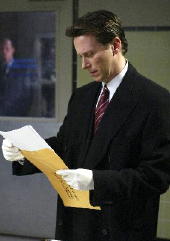
In episode 4, a case of terrorism is reopened when the suspected killer’s body is found under a parking lot — one that had been paved over two days before the killing. The only problem? He can’t be conclusively identified.
Episode 2: A well-known comedy entertainer is gunned down as he enters his home. His wife pleads spousal abuse. Defending her is Charlotte Ellis (Felicity Huffman), one of two possible contenders for Franks’ job in an upcoming election. The deputy mayor is the other.
Episode 1 [and I seem to have done this wrong] centers on the shooting of a prosecution witness while in seclusion. Question: Where did the leak come from?
While the detective work conducted by young Mark Camacho (Bruno Campos) is extremely well conceived — and I do not say that lightly — what makes this series of cases all the more watchable is the peek it provides into the power politics that goes on behind the scenes in the offices of a most highly politically motivated district attorney’s office and his staff, some of whom dislike him very much. Camacho, who’s new on the job, walks right into the midst of it. Who’s loyal to who? That’s what he needs to know, and soon.
One of the few reviews I found of the show called it dull. A typical TV-beat hack reporter at work here. Because there is little actual gunplay (well, now that I think about it, there was once a fairly graphic scene, but all of the other deaths were well after the fact) nor car chases in any of the four episodes, it is therefore dull? Not on your life. The total combined intellectual level is as high or higher here than in any other full-season series I have ever watched. (Admittedly there are very few that fall into that category, but the statement is still true.)
Steven Weber as D. A. David Franks is man of contradictions. Derided by his staff as a hack, he also has a bent for justice, the word “bent” used deliberately, as bending the rules sometimes is exactly what is needed to make the wheels of justice go around. Gil Garcetti, mentioned in the credits, was himself the D.A. for Los Angeles County at one time, as some of you may remember. I’ll bet he wishes some of his cases could be finished in 45 minutes at a time, that’s what I bet.
Note to self: Both Garcetti and James Duff have been involved with another television series, The Closer, shown on TNT. I’ve not been watching it, and perhaps I should have been.
Perhaps the limitation of only four shows was a Good Thing, as certainly there was not enough time in the few episodes The D. A. was on to have the stories to become predictable in any way, for they were not. I was caught leaning the wrong way more than once.
Don’t you just love it when that happens? I do.
« Previous Page — Next Page »









